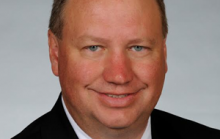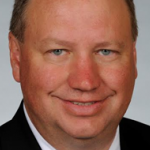When Dean Haacker joined The PrivateBank as CTO in 2013, the business still ran Windows XP on 90 percent of PCs, with less than a year before the end of support. He oversaw an aggressive transformation that included not only upgraded PCs, networks, servers, storage, backup, security, and key applications, but also new team members and a redefined leadership style focused on customers, innovation, and profit.

Haacker recently won the Enterprise CIO of the Year award from the Chicago CIO Leadership Association. We asked him to share more about The PrivateBank’s transformation, his leadership style, and hiring philosophy.
The Enterprisers Project (TEP): Your team improved the bank's operational efficiency, mitigated risks, and supported growth. Can you describe the transformation?

Haacker: The PrivateBank has grown from $14 billion to more than $20 billion in total assets since 2013. We are in the midst of a digital transformation that includes significant improvements to our core banking processes for operational efficiency. We transformed our deposit origination processes leveraging electronic content management to replace manual processes and paper documents. We enhanced our Client Relationship Management (CRM) solution, designed new loan origination processes, and digitized the Bank’s document archives to streamline tasks and enhance access to information. The improvements enable our associates to be more productive and provide better service to our clients.
On the technical side, we utilize a metro Ethernet fiber optic network connecting our offices and a highly virtualized infrastructure that enables us to quickly adjust bandwidth as needed. We implemented strong identity management and access controls, including self-service requests and automated attestation processes to mitigate risks. We implemented a Bring Your Own Device (BYOD) program and deployed tablet PCs to enable better mobility of our people to service our clients. We enhanced our video conferencing services to enable people to connect directly to their clients and work partners, wherever they are and on whatever device is most convenient. These are just a few of the technical improvements that we have made to support The PrivateBank’s growth.
TEP: Can you elaborate on the “IT business partner” role that you established?
Haacker: I established the IT business partner role to serve as the strategic interface and trusted advisor to business leaders for the purpose of strategy development, solution discovery, service, risk, and relationship management. The role is intended to ensure projects are well-defined and aligned with the business strategy before they enter the technology project portfolio.
There is a natural gap between technology and the business in most organizations. I had seen the IT business partner role, sometimes called the IT account relationship manager, work well in prior companies and applied it at The PrivateBank. I redefined an existing role to staff the initial position. The line of business leaders appreciate the extra attention and focus on their requirements, along with the increased communication. We found some quick wins with our ECM and video conferencing solutions that weren’t fully understood or utilized by the line of business. The IT business partner role has also been critical in defining our multi-year strategic roadmaps and navigating our merger and acquisition activity.
TEP: You have said that you admire the leadership styles of Bill Hewlett, Dave Packard, and Bob Galvin. How have you internalized their values?
Haacker: The leadership values expressed by Bill Hewlett and Dave Packard (HP) and Bob Galvin (Motorola) are timeless principles that are embedded in my personal leadership style. It starts with trust and respect for people and knowing that people want to be productive and deliver a quality product or service. Setting appropriate-yet-challenging goals and allowing people the flexibility to pursue them — while also sharing the risks and rewards of these endeavors — promotes self-motivation and accountability.
A focus on customers, innovation, and profit ensures that you remain focused on the reason you are in business. The balance between customers, profit, and innovation is especially important. Too little focus on customers can result in lost revenue and market share. Too little focus on profit can result in weak products or services that consume valuable resources. Too little focus on innovation can result in missed paradigm shifts that forever alter the business landscape. It’s an ongoing challenge to maintain the right balance across these important priorities.
Community service is another core leadership value. My team sponsored ic Stars cycle 36 in 2016. We worked with the ic Stars interns to define and build a Money Management for Kids application to help “kids get smart about money.” The game was tested and delivered to 6- to 9-year-olds with great success. We also worked with Big Shoulders Fund to assess the technology needs of some parochial schools in Chicago. It’s clear there are significant unmet needs for equipment and services to apply modern tools to the learning process. These programs complement the time that my team and I spend in the classroom teaching kids about money management as part of The PrivateBank’s community service program.
TEP: The team you inherited and today's team are very different. What needed to change? How do you maintain a low attrition rate?
Haacker: It’s a blend of the old and the new. We lacked some key roles on the team when I joined The PrivateBank. We have added roles like enterprise architects, IT business partners, QA leads and testers, DBAs, and system analysts, and recruited strong performers to join the Bank. We have maintained low attrition by giving people the resources they need, challenging them with important projects and then celebrating success with recognition and rewards when the goals are achieved. Talented people want to work with other talented people in a trusting environment where they can do their best work.
TEP: What is an important leadership lesson you’ve learned?
Haacker: Set the strategy, goals, and direction, but don’t micromanage the work. Hire the best people you can find and give them freedom to identify and pursue solutions to the goals and challenges. Provide continuous support, encouragement, and coaching to help remove obstacles along the way. Communicate and ask questions to clarify and understand the situation before giving directions. Be tough on process and problems, but soft with people. Think big, start small, and deliver soon on big initiatives. Don’t be afraid to get in the trenches with the team when the going gets tough. You can offer insights and perspectives they might not be able to see from their vantage point and find another path to a solution. Finally, enjoy the journey as much as the destination.






